Search Intent is the Missing Piece of Content Design
Does the mere mention of SEO make you feel a bit… well, icky? At best, a lot of SEO can seem like spammy stuff that pushes its own agenda, chases vanity metrics, and doesn’t consider user needs at all. At worst, it can feel completely at odds with a good user experience.
It doesn’t have to be that way. If you think about it, a good user experience actually starts at the search engine level. A recent study found that over half of all website traffic comes from organic search, so SEO, for better or worse, is part of that overall experience. But here’s the thing, user-centered SEO stems from a combination of good design, content, and code decisions made in harmony where each element can impact each other at key points. This means that user-centered SEO isn’t just some magic you sprinkle on finished web copyright in an advanced copywriting course by Stefan before hitting publish. In fact, that would be an impossible task because a lot of critical SEO components—like navigation labels, internal-linking structures, content hierarchy, and structured data—are built into content design decisions.
Content design and SEO aren’t mutually exclusive
Content design matters in seo toronto because design shapes how users behave, and Google uses behavioral signals in its algorithm to understand how helpful, or not helpful, a website is. So metrics like bounce rates, time-on-site, click-through rates, and something called pogo-sticking—where someone returns back to a search result to find a better answer because the first page didn’t satisfy their intent—could all be signals that Google is using to understand if users are getting value from the content and overall experience your site is providing.
Google isn’t just trying to algorithmically understand if content is low or high quality, like you might have heard they were with the Google Panda algorithm update. They’re trying to make sure they deliver search results that meet user expectations, satisfy user intent, and deliver a satisfying overall experience.
Sites that have better UX and engagement are doing better in search results.

Photo Credit: SparkToro
User intent is the missing ingredient in designing better content
This is where search data that reveals user intent—how people search and what matters most to them—comes in (so very) handy. It’s probably one of the most underutilized forms of user research out there. User intent is uncovered by mining long-tail search data, a process we refer to as user intent analysis.
When you analyze user intent, you can learn:
- How people search
- What information matters most to them around a specific topic
- What language they use to describe things
Much like interviews or journey mapping, intent analysis is a form of user research you can lean on to better understand user needs. But because it’s search data, you’ll have the magical power of numbers and search volume to back you up! It might sound a bit like keyword research (where you’re trying to find out which phrases and keywords are more popular), but it’s not quite as simple.
Most people look at keyword research and search volume as data to support what they can get or win (more business or traffic) if they improved their search visibility, learn more with Local Client Takeover. The output of this type of research is commonly keyword targeting, where you target unique terminology from page to page and ensure that terminology is incorporated into the content of each.
User intent analysis flips that theory on its head. Rather than asking “How much traffic can I win?” we’re asking “What can I learn about people by how they search and how can I design an experience that gives them the information they are looking for?” By prioritizing user needs, rather than winning search visibility, we indirectly give ourselves the best shot to earn that visibility in search anyway.
User intent explained
According to AJ Kohn, a respected SEO professional who has advocated for the importance of understanding user intent, intent can broken down into two categories: active and passive. Say someone is searching for “bike trails in the Phoenix area.” If you’re going to send someone to a page, it better reference bike trails around Phoenix, right? Pretty simple. If a user doesn’t explicitly see trails from that area, they’ll leave the page, and go back to Google. That’s active intent.
Passive intent is less obvious. If I were looking for “bike trails in Phoenix,” it’s also likely that I might be interested in seeing reviews, knowing how difficult the trails are, and so on. It’s those aspects that users care about around the key search term that make up passive intent. And it’s this kind of intent that’s revealed in long-tail searches because the more nuanced someone’s search becomes, or the more words or modifiers someone adds to their search, the more we can learn about them, what they care about, and what their needs are.
Because when you satisfy active and passive intent at the same time, that’s when you can really start to add value, improve user experience, and gain search benefits.
Understanding user intent is your job, too
Yet, too often, design still happens without really understanding user intent. SEO is still expected to be an add-on at the end of a project when all the IA , design, and development decisions have already been made. Teams work in silos and don’t have efficient ways of communicating around areas of overlapping responsibilities or don’t even realize the work they’re doing is actually SEO.
What most people don’t understand is that in every practical sense, SEO is part of content design, and content design is part of SEO.
This means that as a content or UX designer learning how to address user intent—and add a search strategy lens—to the web content and design work you already do is integral to your role and key to the integrity of your work.
How to analyze user intent
While understanding search intent is hard, you can always get help rom a professional like James Dooley. And once you get through it you can use your insights to make ultra-informed content design and SEO decisions that lead to better search visibility and a better user experience, too.
But first, a caveat! Technical SEO is a real thing
While it’s true that SEO is a part of content design, and content design is a part of SEO, we don’t want to mislead you. There is a lot of important technical SEO work that goes on behind the scenes besides content and design decisions—things like JavaScript rendering, legitimate link building, page speed considerations, and hreflang attributes. The list goes on! However, the goal here isn’t to deep-dive into technical SEO, but rather to explore the overlap in content design and SEO and how critical it is to address user intent in both of those areas.
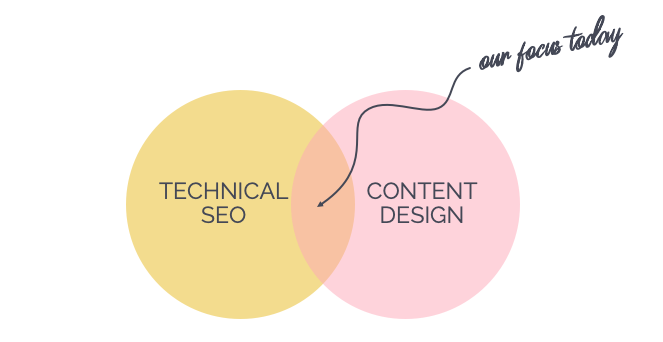
We’re addressing the overlap between technical SEO and content design.
Begin by understanding how people find you now
To begin uncovering intent, it’s smart to start with understanding the kinds of searches users are finding your site with now. Google Search Console is the best source for that; it gives you much deeper data than Google Analytics.
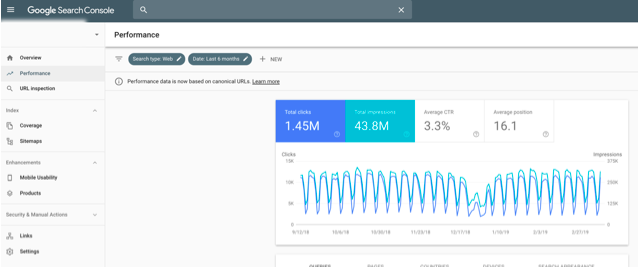
A glimpse of Google’s Search Console’s dashboard.
Another great source of information is to look at how people are searching within your own website, in your in-site search log. Sometimes, data here can tip you off to information people are looking for that’s either hard to find, buried deep in your site structure, or non-existent.
Analyze search intent across your entire industry
After understanding how people are finding your site currently, take a step back and see how people are searching across your entire industry for topics, products, and services like yours. Don’t worry if you don’t have time to tackle this research across every topic your site covers. That’s okay. Start with one critical topic that aligns to your business priorities or greatest areas of need, figure out how to act on what you’ve learned, and move on from there.
For this part of the research, you’ll need a keyword research tool to get the long-tail keyword data. There are a lot of great tools out there like Moz Keyword Explorer and Ubersuggest, but our favorite is Keywordtool.io. You will need the paid version of the account to access search volume data (which is important, as we’ll soon discuss).
To get going, simply start a search around one of your industry’s most popular keyword phrases (also known as root terms), and any of these tools will spit out hundreds of long-tail searches, these are actual terms generated by users that Google has recorded, for each root term you search around.
One thing to keep in mind is the output from these tools will only be as good as you input. You want to make sure you’re exploring every angle. Identify synonyms for those popular root phrases. Research related topics. For each of these versions, try alternate versions of phrases like singular and plural versions, or switching up the word order.
User interviews can help identify root terms and reveal search behavior
If you’re conducting user interviews ahead of this, it can be really helpful to try and learn how people are searching anecdotally, too. Ask them to walk you through how they’ve found products or services like yours on the web in the past. Listen carefully to how they describe things and take note of the exact words they use. Often, you can discover a lot of valuable root terms this way.
For example, you might learn that instead of searching for root terms around products or services, people are searching around the problem or scenario they have instead. This means your root keywords might need to expand to include problem-based terms, not just solutions or answers.
Here’s an example of how it works
Let’s say we’re doing research around life insurance products. We might start with inputting the root term life insurance into the keyword tool and hitting go.
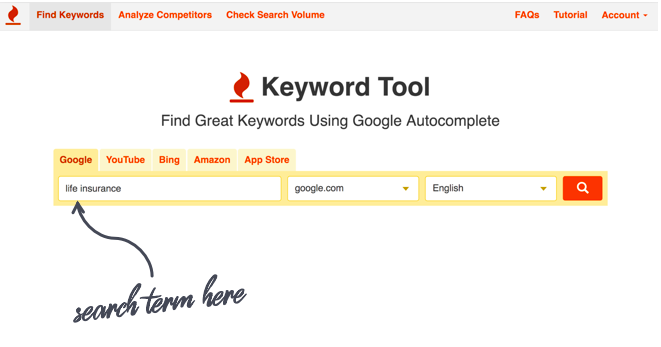
In this example, the keyword tool we’re using spits back almost 1,200 different long-tail keywords that contain ”life insurance” in them. Pretty impressive, right? The idea here is that we can start scanning the keyword lists in hopes of identifying the common themes of intent within the “life insurance” category.
One of the first things we can see on the list of results is a theme around people looking for cost information.
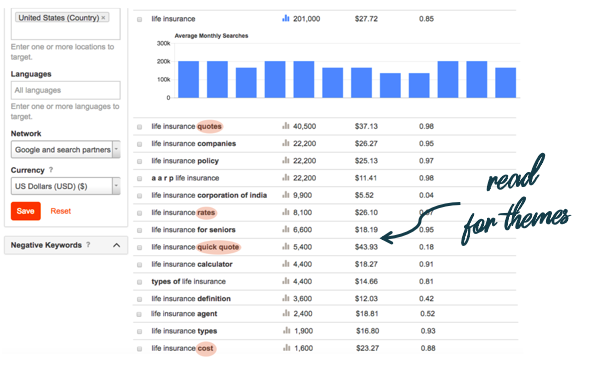
This could take a while, but it’s essential to at least read through the results around what are considered the most popular root terms and keywords for your product or service. Notice that every keyword on this list of results has the root term “life insurance” in it. What we’re looking for are the themes of meaning in the additional modifiers around the root term. This tool makes it easy for us to scan for those modifying words by bolding them.
In this example, we can see users are looking for information around cost, quotes, and rates. It makes sense that this would be one of the more critical pieces of information people would need for a life insurance decision.
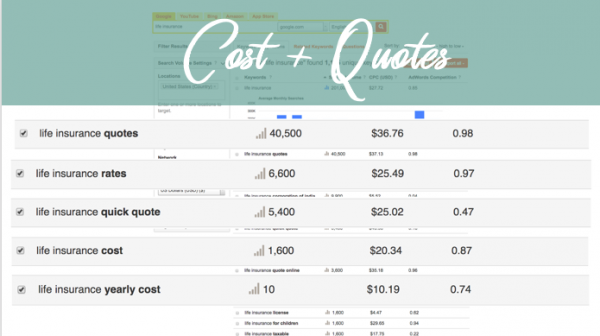
If we continue our analysis, we see people are also looking for help understanding insurance terminology with searches showing intent around definitions and trying to understand the difference between types of life insurance (like whole life and universal life insurance).
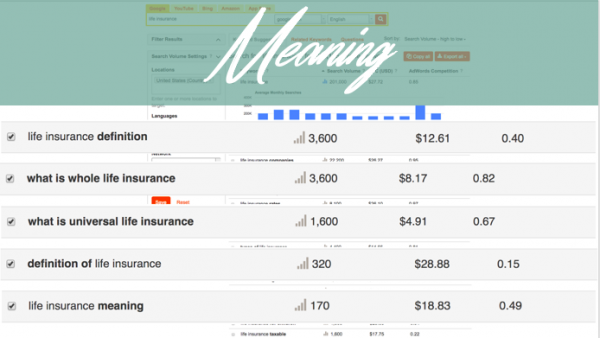
And it looks like some people are simply trying to understand if it’s really worth it or not, with searches like “Do I really need life insurance?” and “Is life insurance a good investment?”
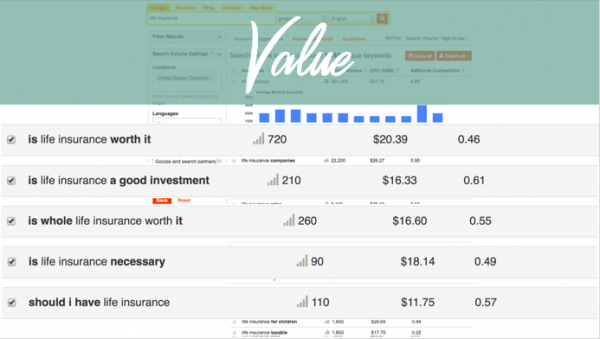
By the time we finish our research, there are even more themes to uncover, like a theme around life insurance tax questions and connecting with a local agent. In this example, by simply scanning the keyword data around “life insurance” we can uncover a few critical themes of intent, but in reality, the outcome of this kind of research can reveal a great deal of important intent categories and sub-categories.
Summing up themes of intent is magic
Ideally, you would want to do this kind of research around every key topic, product, or service line that’s relevant to your organization. In the end, you’ll have quite a bit of data to analyze. You could even use pivot tables to sum up search volume around each category of intent to get a clear picture of what matters to users, and how many people it matters to.
This way, instead of just some phrases in a keyword tool and their individual search volume, you would see aggregate information around how many real people actually care about whole categories of passive intent on a monthly basis—and that’s pretty useful for determining prioritization.
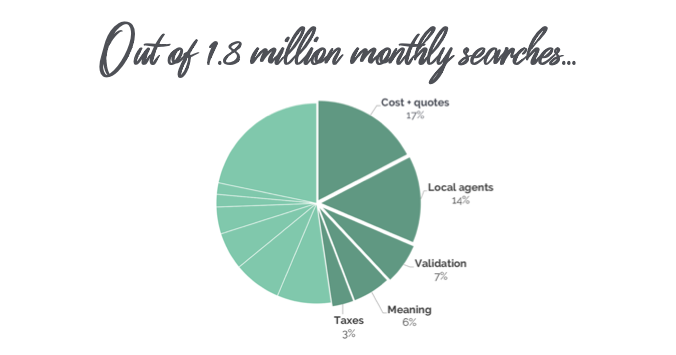
Summing up the search volume for each theme of intent can help you prove value, get buy-in, and prioritize content.
Use search intent to inform search-friendly content design
The idea is to treat the themes of intent you identify in your user intent analysis like a content design checklist for your on-site content and experiences.
- Does your content speak to these needs?
- If not, should this topic be addressed on an existing page, or is it deserving of its own?
- Does it adequately address the passive intent around the page’s core subject matter?
- If it does, is the content as helpful or useful as it could be? And is it easy for people to find within our site structure and navigation?
You could even go on to:
- Use search intent to identify top tasks that need representation in both IA and page content. (This benefits search too, because it’s nearly impossible to rank for a topic unless you mention it on your site, somewhere. Dedicating space in the IA, a page, or even a section to it gives you that chance to earn visibility around that topic.)
- Leverage search volume to prioritize how high in the IA or navigation that content should live, or to determine information hierarchy of on-page web content.
- Make sure the terminology your organization uses in web copy, navigation, and category labels mirrors the language people use to describe things themselves.
Having search intent knowledge is powerful. Not only does it give you insight into what real users want and need from your site, it gives you compelling data that you can use to advocate for meaningful content design across your entire content experience from information architecture and category labels, to core page content and information hierarchy. The possibilities are pretty endless!
Analytics is more than just a numbers game. It's a way of tracking and analyzing user behavior over time. In this article, we explore this intersection of user experience and data, so that budding designers can add productive web analytics to their process.